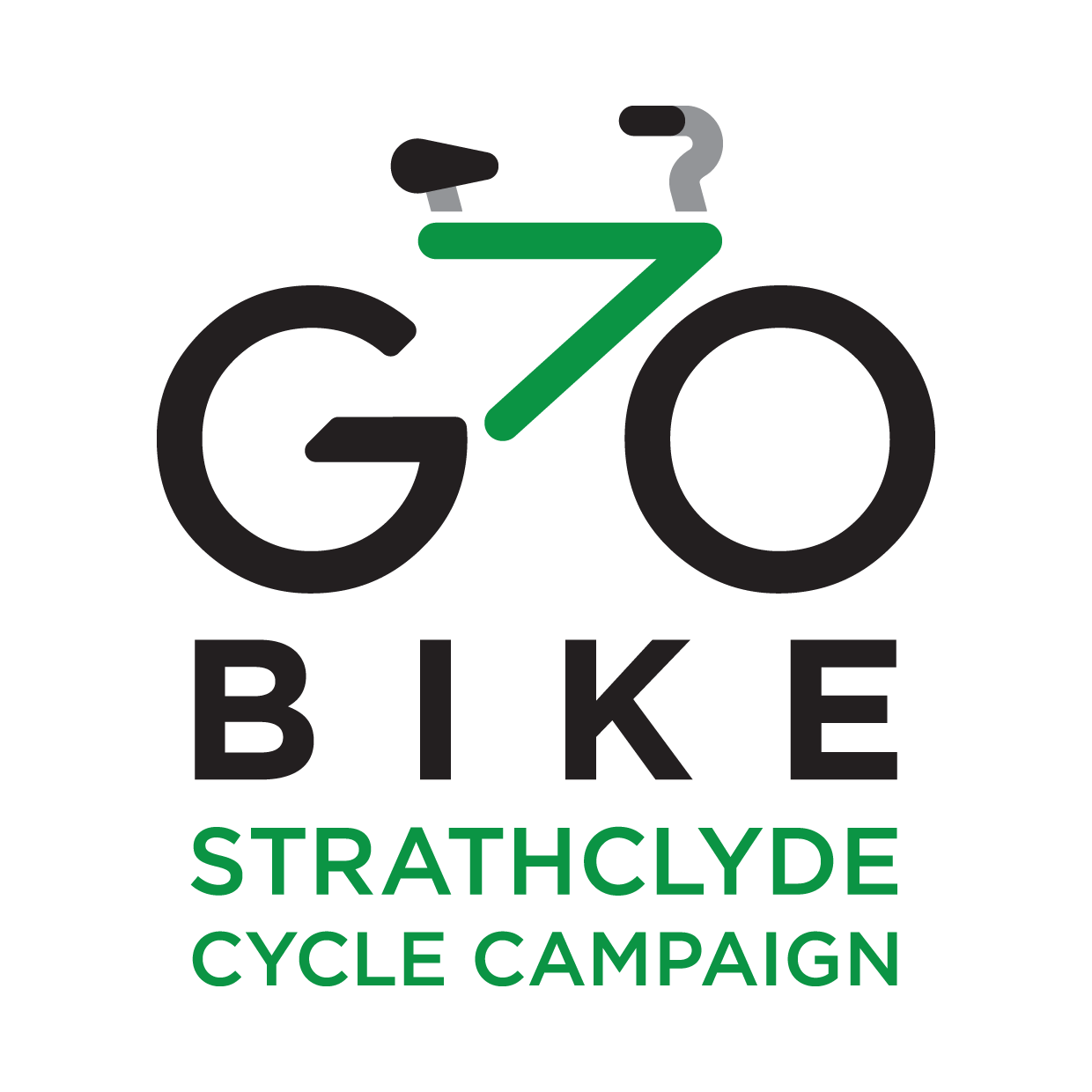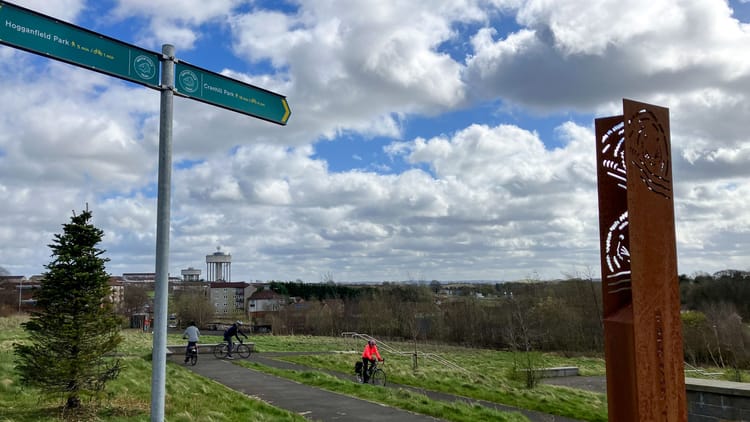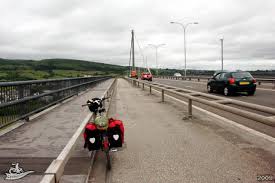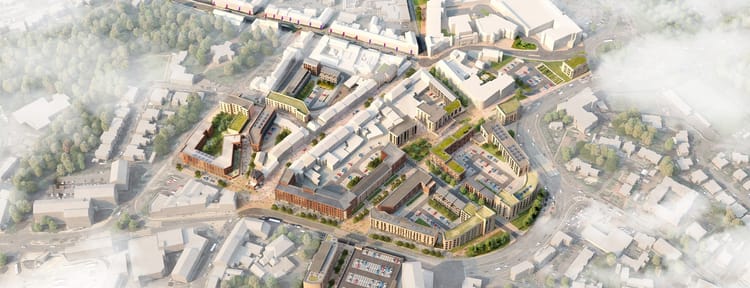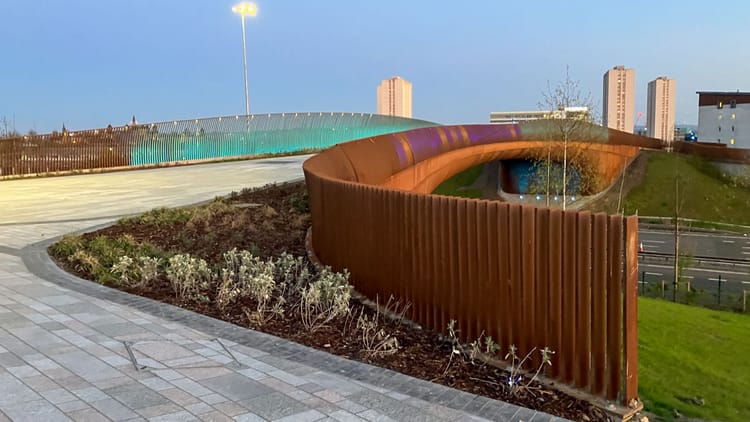Road Design Challenges for People on Bikes (2) – Shared-Use Footways
The Trouble With Shared-Use Footways
As the Strathclyde Cycle Campaign, GoBike has long been frustrated by substandard provision for active travel across our region. Despite campaigning for years against certain designs, we are continuing to see them used across road improvements and in newly funded projects
In the second of three blogs, our co-convenor Iona looks at shared-use footways on the pavement, and the challenges they create for both people on bikes and those sharing that space with them. People on foot, with prams, wheelchairs, sight impairments, children, dogs and everybody else requiring to use a pavement.
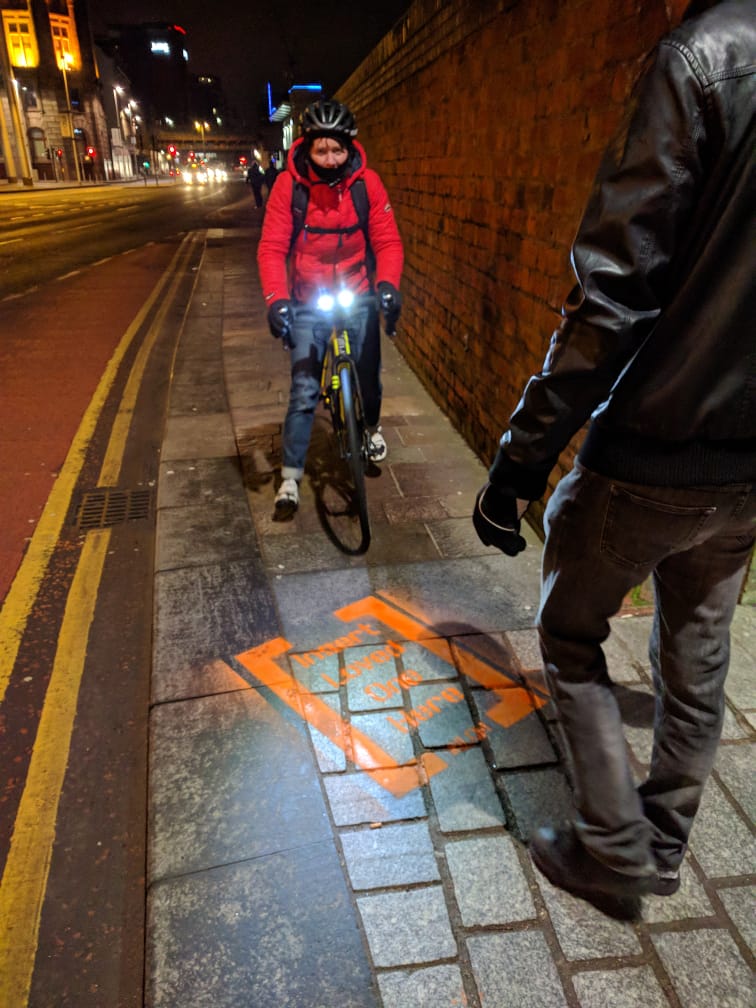
What are Shared-Use Footways?
A shared-use footway is a pavement level route next to a roadway, designed to accommodate both “pedestrians” and “cyclists” [1]. The Cycling Embassy of Great Britain goes as far as to note in their definition of shared-use as “resulting in very low standard cycling infrastructure” [2]. It is useful to note that certain types of shared-use can be called ‘segregated shared-use’. This is where attempts are made to separate the users with lines, paving colour, street furniture or a curb, but by keeping the cycling on the pavement level, the shared nature of the footway remains. ‘Segregated cycle tracks’ are very different, and will always be at carriageway level, and physically separated from both pavement users and other motor traffic into a space designated specifically for active travellers.
Conflict
The biggest issue with shared-use footways has always been the conflict that results with putting users of a space together, who are moving at different speeds. People not on bikes feel threatened by faster moving machines travelling close beside them. Equally, people on bikes feel endangered by the unpredictable path that those around them might take. Anyone travelling on a bike through a shared-use area needs to (and should) slow their speed drastically to prevent any conflict and so, for a route like a commute used to travel to a destination, the use of the provision is often impractical.
Even by the very minimal standards of the design manual Cycling By Design used by Glasgow City Council, the combined density of pedestrians and cyclists for shared-use footways should be no more than 200 users per hour per mile [3]. This is something that is often disregarded when shared-use is designed in, particularly around busy shopping areas. As well as affecting perceived danger, in a report by Living Streets, it was noted that the ratio of cyclists to pedestrians can also affect how comfortable a place feels [4]. Other things common across shared use provision are obstacles such as street furniture and diversions around bus stops - not something at all desirable when trying to get to work as quickly as possible without the car. A notable section that illustrates this is the shared-use footway found at the Broomielaw along to the SECC. While busy with bikes during commuting times, people on foot struggle to find safe space, yet at other times, tourists can often bring people cycling to a standstill.
Signage
It is common in Glasgow to find shared-use footways that disappear just as silently as they appear. Due to a lack of signage and no linking up of the network, it can be difficult to know where the provision starts and ends. As many councils deem cycling on the pavement a fineable offence, this can not only be confusing, but also worrying. One of the most commonly quoted misconceptions about cyclists is that they are “a menace because they all ride on the pavement”, and yet in areas where shared-use is common, it is easy to see where this misconception comes from. Nitshill Road is a dual and sometimes three lane fast carriageway in both directions leading to the M77. Here only broken up sections of the pavement are designated shared-use. People on bikes are presumably expected to hop off and on the pavement into the fast moving traffic if they choose to use it.
Maintenance
Priorities within our councils for road maintenance currently sit firmly in favour of the roads. Shared-use footways can be rendered useless throughout every part of the year, by uncleared fallen leaves, ice and snow, broken glass, and even often, signage for people in cars. This photo shows an example along the shared-use footway on Barrhead Road leading to Silverburn, where even regardless of the poorly placed sign, leaves are left uncleared and gritting is scarce.
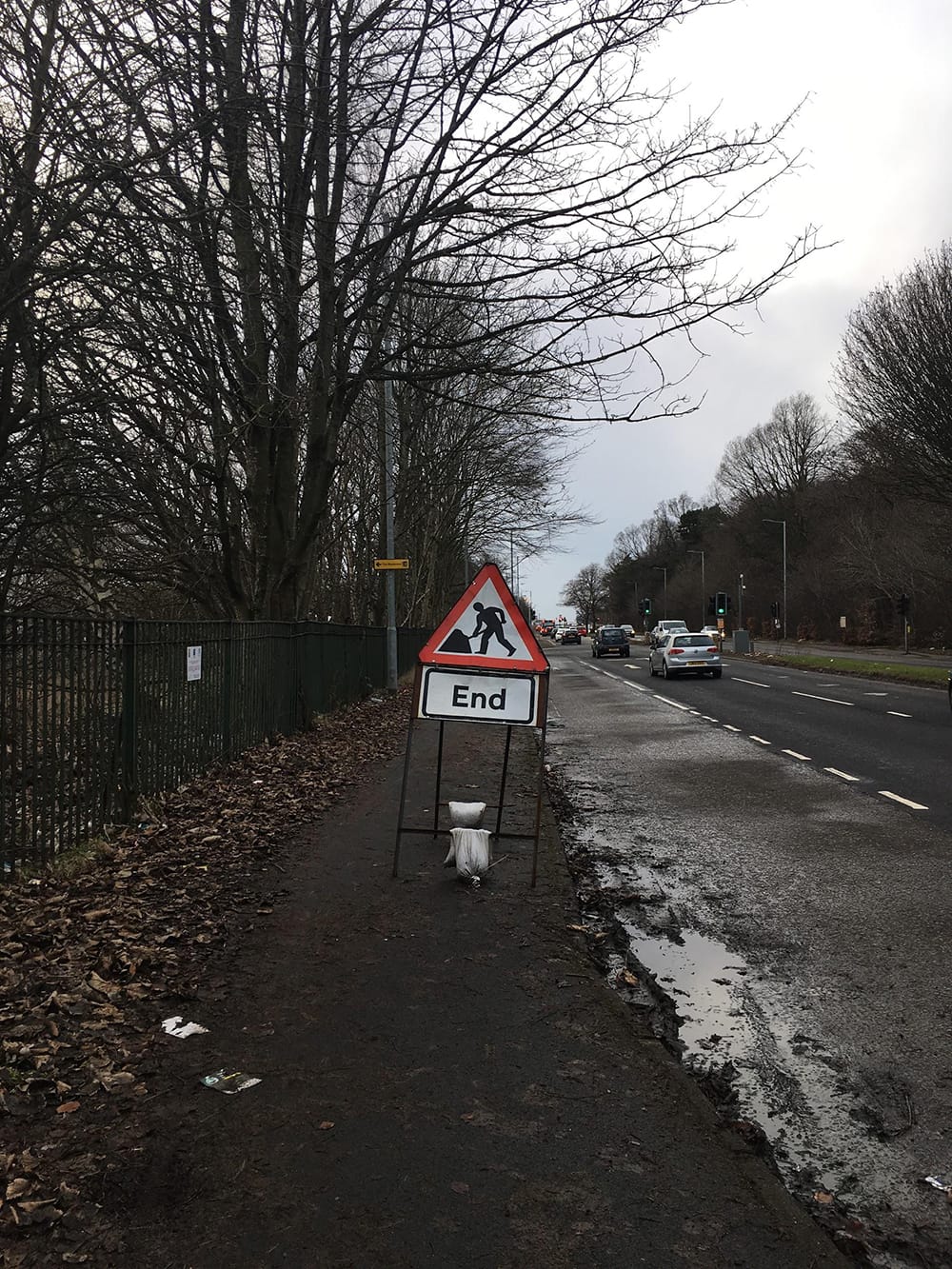
Leisure Paths
Very separate from infrastructure for active travel, we do have several quiet and picturesque leisure paths in and around our city. These shared-use paths provide space for people to enjoy the countryside, such as along the Firth and Forth Canal, through Pollok Park, and along the old railway line in Paisley. These long uninterrupted routes allow children and adults of all ages to ride on bikes in safety, far from traffic, and yet the shared-use natures of these paths only work here because the volumes of people in these spaces are low. Transfer this to the busier urban environment, and it is a recipe for confusion, conflict, and dissatisfaction for all users [5]. It is desperately important that we see new provision for the same people we see using bikes on leisure paths extend into the city, and on our high streets, with properly segregated routes for use for all ages and abilities.
The Future
In Glasgow we have a proliferation of shared-use footways which, due to their low cost and ease of passing through the legislation to implement them, have historically been put in place seemingly at random around the city. The good news is that recently a number of high profile segregated cycleways have started cropping up, such as the South West City Way in Tradeston, and the much anticipated South City Way along Victoria Road. We applaud these projects, which despite the political challenges involved in pushing them forward, provide safe space for active travellers of all ages and abilities. However, these safe refuges are short in distance and don’t currently link up to a wider network. There are no safe routes for people to get to and from them. We still have a long way to go before our cycling provision will allow for the uptake of active travel anywhere near Transport Scotland’s promised 10% of journeys by 2020 [6]. To get there, well designed segregated, and not shared-use, provision needs to be designed as standard with any money currently being spent on road improvement projects. Unfortunately this is not a given and we are still seeing shared-use footways pushed through under the radar such as in Govan, and as a part of high profile newly proposed road improvements.
Making Space for Cycling, a guide for new developments and street renewals, states as point 3 in it’s Principles in Practice, that “people prefer cycling away from pedestrians - shared-use pavements alongside roads benefit nobody. Such pavements are inconvenient, slow, and misappropriate space from pedestrians” [7]. It has even been said by Brian Deegan, one the UK’s leading street design engineers, that the reliance of shared-use as a design could reduce the propensity for people to cycle [8]. At GoBike we completely agree, and call for our councils to look at the evidence for why shared-use is not an option for a linked up network in our city, that will encourage more people to leave the car at home and make the active travel choice.
[1] Department for Transport ‘Shared-Use Routes for Pedestrians and Cyclists’ 1.2 https://assets.publishing.service.gov.uk/government/uploads/system/uploads/attachment_data/file/9179/shared-use-routes-for-pedestrians-and-cyclists.pdf
[2] Cycling Embassy of Great Britain ‘Dictionary - Shared-Use’ https://www.cycling-embassy.org.uk/dictionary/shared-use
[3] Cycling By Design 2010 Table 6.1 /content/files/media/14173/cycling_by_design_2010__rev_1__june_2011.pdf
[4] Living Streets ‘Sharing the Space: A Study of Four Shared-Use Paths in London March 2016’ https://www.livingstreets.org.uk/media/1864/sharing-the-space-report.pdf
[5] Cambridge Cycle Campaign ‘The Case Against Shared-Use Provision’ https://www.camcycle.org.uk/newsletters/111/article11.html
[6] Transport Scotland ‘’Cycling Action Plan for Scotland: 2017-2020’ Pg 7 /content/files/media/10311/transport-scotland-policy-cycling-action-plan-for-scotland-january-2017.pdf
[7] Making Space for Cycling ‘Principles in Practice’ No. 3 http://www.makingspaceforcycling.org/#principles
[8] Brian Deegan ‘Cycling Infrastructure in London’ ICE Publishing https://www.icevirtuallibrary.com/doi/pdf/10.1680/jensu.15.00001
